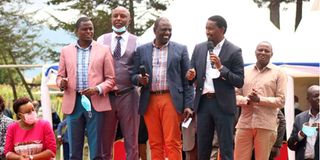Winners and losers in the new scramble for the soul of Mt Kenya

Deputy President William Ruto (centre) with some Mt Kenya leaders at Engineer, in Nyandarua County, on February 14, 2021.
What you need to know:
- In the past, the region’s elite led the pack in the scramble for votes in other parts of the country.
- This enabled the region to produce three out of independent Kenya’s four presidents.
As the August 9, 2022 General Election beckons, presidential hopefuls are rushing to win the hearts and minds and consolidate influence in the Mt Kenya region.
The region’s 10 counties, which collectively contribute 28 per cent of Kenya’s Gross Domestic Product (GDP), are estimated to reach 10.2 million voters by next year. And the radical shift in the region’s political fortunes is spawning its clear winners and losers.
The stakes are high for the region, which has been likened to a beautiful girl who is being coveted and fought for by multiple suitors.
In the past, the region’s elite led the pack in the scramble for votes in other parts of the country. This enabled the region to produce three – Jomo Kenyatta, Mwai Kibaki and Uhuru Kenyatta – out of independent Kenya’s four presidents. The acme of their success came in the December 2002 elections, which was a stark choice between two sons of the region: Kibaki and Uhuru.
Temporarily, the 2002 contest shifted the axis of competition from ethnicity to a clash of generations.
However, from 2007, the region faced a serious propaganda blitz. The region’s elite were demonised as “Mount Kenya Mafia” and the December 2007 election touted as a contest of “41 against one”. This set the stage for the 2008 post-election violence, which claimed an estimated 1,500 lives, displaced more than 600,000 people and destroyed property worth billions.
But the region held together and gained a sizeable share of government after the 2007, 2013 and 2017 elections. So, why has the hunter of yesterday become the hunted of today?
Propelling the new scramble for Mt Kenya is the fact that Kenya’s 11-year-old Constitution does not allow Kenyatta to seek a third term – and he has not moved to prolong his stay in office.
In March 2018, Kenyatta struck a peace deal – the famous “handshake”– with opposition leader Raila Odinga. The handshake ushered in one of the most peaceful spells in multiparty Kenya. It, however, pushed the scramble for Mt Kenya to a whole new level and has split both the Jubilee administration and the opposition National Super Alliance (NASA). However, it is not patently clear what victory looks like for Kenyatta’s post-2022 election phase in the ensuing political détente, which is premised on the Building Bridges Initiative (BBI).
For Mr Odinga, constitutional reform is the clear path to victory in the 2022 election. The strategy treads a familiar trope: build a broad-church coalition for a referendum and ride on the political momentum to victory.
To be sure, the BBI campaign has enabled Raila’s ODM to penetrate and gain formidable allies in a traditionally hostile region. In mid-June, business mogul Jimmy Wanjigi announced he will vie for the presidency, first by challenging Mr Odinga for the ODM ticket.
Cord coalition lost
However, victory in plebiscites has not translated to victory in presidential polls. Despite a 54 per cent win in the November 2005 constitutional referendum, the winners lost the 2007 polls.
Similarly, despite a nearly 70 per cent victory in the August 2010 constitutional referendum, the Cord coalition lost the 2013 presidential poll.
Although Mt Kenya’s 10 county assemblies endorsed the BBI Bill, and at least 235 MPs voted for it, on May 27 the High Court blocked it. The appelate court is expected to give its verdict on August 20 2021.
Deputy President William Ruto was the main loser in the handshake and its aftermath. On January 22, 2019, Ruto was technically locked out from overseeing government's projects. Executive Order Number 1 of 2019, appointing Interior Cabinet Secretary Fred Matiang’i chairperson of the National Development Implementation and Communication Cabinet Committee, further clipped Ruto’s wings.
However, Ruto has emerged as “the man to beat”. This week, the influential African Confidential magazine carried an eye-catching header: ‘Why the Dynasties Fear Ruto’ (Vol 62, No.14 July 8, 2021). With rivals mired in litigation to salvage the BBI and the opposition squabbling over leadership, Ruto is having a field day in consolidating his stranglehold in Mt Kenya and the country.
On July 3, 2021, he hosted 270 ward reps from the region at his Karen residence. This has increased Ruto’s opportunities to raise campaign funds locally and internationally and emboldened his networks in the Mountain region. His networks snatched Rurii and Juja seats from Jubilee. The Kiambaa by-election is a toss-up between Ruto’s United Democratic Alliance, and Jubilee. Also gaining traction is the divisive “hustler” ideology.
“My Agikuyu people have long been known for industry and wealth,” Prof Ngugi wa Thiong’o lamented recently, “But I have been observing with trepidation how they are led astray to reject wealth and build a new identity called ‘hustler’. This is how you destroy a community: you make them associate poverty with virtue and wealth with vice.”
On July 5, 2021, Jubilee Secretary-General Raphael Tuju revealed Jubilee and ODM were working on an omnibus alliance seemingly to break the Ruto wave. However, without a strong candidate from the region, Jubilee risks sliding to the margins.
National Assembly Speaker Justin Muturi is the man after Kenyatta’s mantle. His coronation as Mt Kenya spokesperson on May 22, 2021 and public declaration that he will be in the presidential race on July 4, 2021 have triggered serious debate on the future of power in the region. But the big question is whether his entry into the scene will enhance the region’s gains from the new scramble.
Professor Peter Kagwanja is a former Government Adviser and currently Chief Executive of the Africa Policy Institute.





